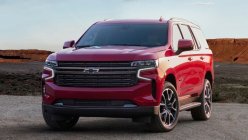In your journey in the automotive world, you might have encountered the terms; rear-wheel-drive, or front-wheel-drive. Or even much more confusing abbreviations like FR, FF MR and what not. Well, dear Philkotse.com reader what you’ve heard is what is called a Car Layout.
Now the term car layout has been defined as where your vehicle’s engine is located and which wheels power your car. As you might’ve known all along…or not, not all cars have their engines located in the same place nor are they driven forward in the same manner.
For the sake of simplicity, let us limit the categories which we will define and discuss into three: front-wheel drive, rear-wheel-drive, and four-wheel-drive. Now don’t get us wrong, we know that there are many other categories out there that are either too inefficient or just too plain weird, or just too obscure for us to cover.
You know, like the UK Patent GB2351051 which is a “rear engine, front wheel drive vehicle” made by the Rover Car Company in Britain. It is just too strange and probably too complicated to use in a mass production vehicle.
1. Front-wheel drive vehicle
Now front wheel drive vehicles or FWD for short, are vehicles whose front wheels are driven by the engine and as we all know, is currently the most commonly used layout because it is easier to develop, easier and cheaper to produce, and of course much easier to repair.
Typically a front wheel-drive with a transversely positioned engine at the front is used for this layout. Why is it easier in general? That’s because cars with these kinds of layouts have its engine and drivetrain in a single unit thus providing more space for passengers and the like.
Also because of this more compact configuration, cars can become lighter and can be powered by more economical engines.
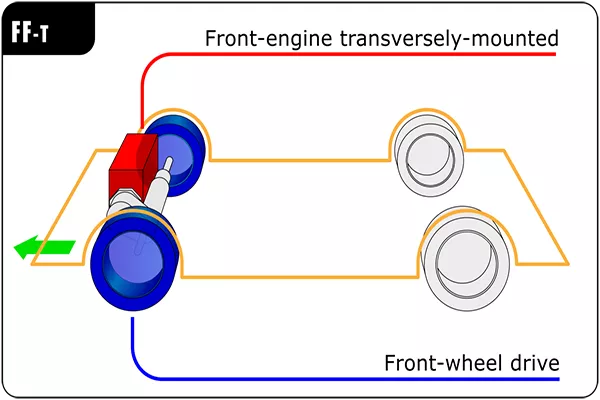
The front engined, front wheel drive layout
Three subtypes of the FWD layout
Front-engine, front wheel drive
Is a car layout where the engine is found at the front and the front wheels are driven by the engine. As we have mentioned earlier, this layout has become very prominent for quite some time now mainly because it is cheaper for manufacturers to produce.
Because of the very compact nature of this layout, cars have become very light weight as there is no longer a need for those long and very heavy drive shafts you can see that are common in rear wheel drive vehicles in the Philippines like cargo trucks and jeepneys. A few examples of this very popular layout include the 2018 Toyota Corolla SE, the 2005 Honda City iDSI, the 2000 Honda Civic SiR, the 2016 Hyundai Accent and many others.
Mid-engine, front wheel drive
These can be found in the earliest FWD cars back in the 1930s. Instead of having the engine positioned at the front of the vehicle, it is instead located somewhere in the middle.
Rear-engine, front wheel drive
This layout is where the engine is located at the rear while the front engines are driven by a driveshaft. Imagine a rear wheel drive vehicle but backward. For this reason, this layout is very unconventional and is therefore only used on prototypes or concept cars.
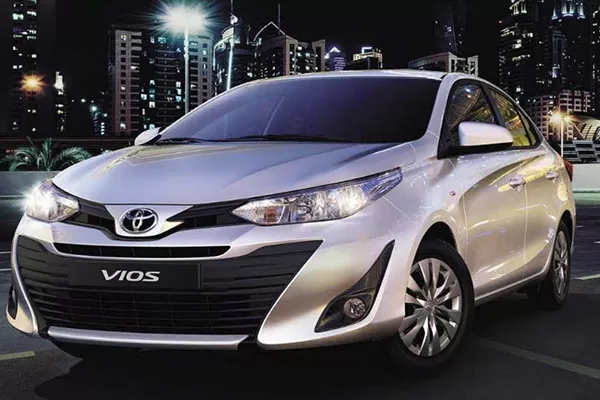
The Toyota Vios is a common front wheel drive vehicle here in the Philippines
All FWD cars are easier to produce and easier to maintain. Aside from that, cars with this layout can provide passengers with more legroom, can carry fore luggage and/or passengers and is overall a cheaper design.
Now it isn’t all rainbows and butterflies for the front wheel drive layout as it also has its own set of disadvantages. First, when it comes to driving dynamics, FWD vehicles have a greater propensity to understeer since the majority of its weight is located up front.
Next, FWD cars have lower towing capacity than rear wheel and four wheel drive cars. And third, cars that usually come with these kinds of the layout are run of the mill cars made for daily driving.
That doesn’t always hold true as there are exciting cars out there like the 2019 Honda Civic Type R, a high-performance FWD car that can be loads and loads of fun to drive.
2. Rear-wheel drive layouts
In this layout, the engine is usually found at the front of the car and the said engine is mounted longitudinally meaning its crankshaft is parallel with the vehicle, front to back.
The engine then turns a driveshaft which powers the rear wheels hence rear wheel drive or RWD for short. In most RWD vehicles, the engine will require more parts in order to provide power for the rear tires and thus is more expensive for manufacturers to produce and certainly more pricey for the would be a car buyer.
Nowadays rear wheel drive vehicles are commonly used in larger vehicles like SUVs, some VANs, a majority of cargo trucks, a lot of pick-up trucks, jeepneys, and many high-performance vehicles. This is because vehicles with RWD layouts have better torque, and has better handling due to “load transfer” during acceleration.
RWD vehicles are also easier to intentionally oversteer or what they call”drift” than other layouts and it is for that reason why many performance vehicles have this layout.
Notable examples found today including the 2019 MX-5 Miata, the 2019 GT86, the 2019 BMW Z4, the 2019 Toyota Fortuner 4x2, the 2019 Toyota Hilux 4x2 and of course the perennial Philippine Jeepney.
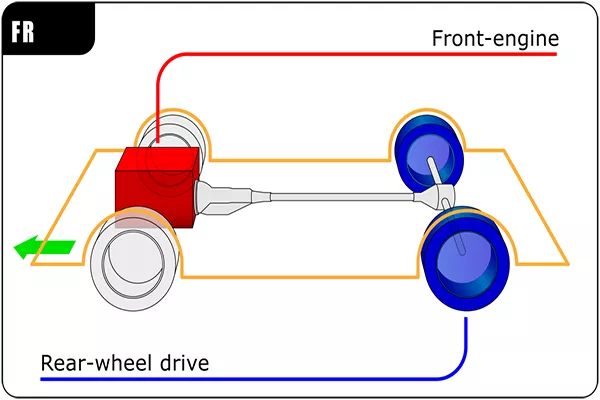
The front-engined, rear wheel drive layout
Three sub-types of RWD
Front engine, rear wheel drive
This layout, which is often abbreviated as FR is a layout where you can find the engine located at the front while the rear wheels are driven. It is one of the more common rear wheel drive layouts out there and is certainly one of the oldest vehicle layouts in general.
Mid-engine, rear wheel drive
Instead of the front, the engine is located at the center of a vehicle, typically behind the passenger compartment.The difference between this layout and the rear engine one is that this layout’s center of gravity is located at the front of the rear axle thus providing the vehicle very favorable weight distribution. As such many super cars use this configuration. Nonsuper cars like the 1991 Suzuki Supercarry also use this to maximize space.
Rear engine, rear wheel drive
This layout, which is also known in short as RR has both its engine and the drive wheels located at the rear of the vehicle. This is common in many buses as it eliminates the need for a drive shaft. No drive shaft = cheaper vehicle to produce. While common in buses, this layout can rarely be seen from other vehicles.

The Jeepney is a common front engined, rear-wheel drive vehicle in the Philippines
Like the FWD, the RWD layout can also have a host of disadvantages. First, an RWD vehicle can certainly be more exciting to drive but can be difficult at times. In modern cars however those difficulties maybe alleviated by using traction control and other electronic driving aids.
Another is that RWD vehicles have less interior space. Notice that large bulge in the seats in some SUVs? Yep, that’s the transmission tunnel and driveshaft running through the length of the vehicle towards the rear wheels.
Next, RWD vehicles tend to have traction problems in wet, slippery road surfaces but as we’ve mentioned before, those can be eliminated by activating the myriad tools made available in modern RWD cars. That can become very expensive.
>>> Must read: 4 simple methods to tell if a car is a front-wheel drive or rear-wheel drive
3. Four-wheel drive layouts
Now in this layout, drivetrains are designed to deliver power to all the tires of a vehicle. As such, vehicles with this kind of layout tend to have other applications that just running around on smooth, comfortable highways.
Instead, some are designed to tackle very harsh terrain or unconventional driving surfaces. Vehicles with these layouts can either be called a 4wd or four-wheel drive, 4x4 (four by four) or AWD or all-wheel drive. What sets an AWD from a 4WD is that the AWD uses a front, rear and center differential whilst the 4WD only uses two differentials and a transfer case.
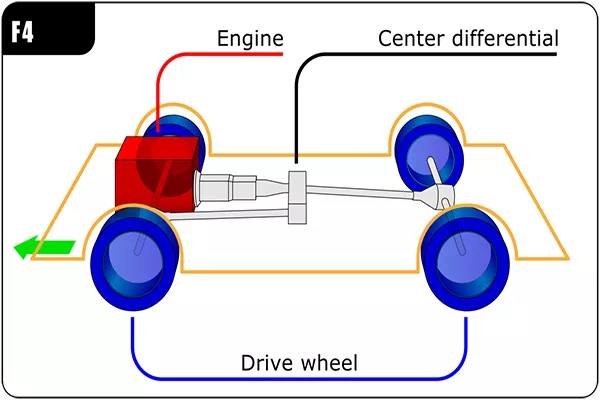
The four-wheel drive layout
In most four-wheel drive vehicles today, the 4WD can often be deactivated and activated with a simple press of a button. This is so because using the 4WD mode on a simple highway or road driving can be detrimental to your car and your wallet.
In very old 4WD vehicles, one needs to stop, get out, and manually turn a switch to mechanically activate the system. In many recent vehicles, one merely needs to press a button.
In talking about the advantages of a 4WD, one merely needs to watch a video from youtube of a jeep climbing some rocks in Nevada. Or see that meme called It’s a Jeep Thing where jeep owners drive their beloved vehicles through a three feet deep mud pit successfully.
>>> Also check out:
In seriousness though, 4WDs can vastly improve traction in many sketchy driving situations like driving through sand, mud, rocks, etc.
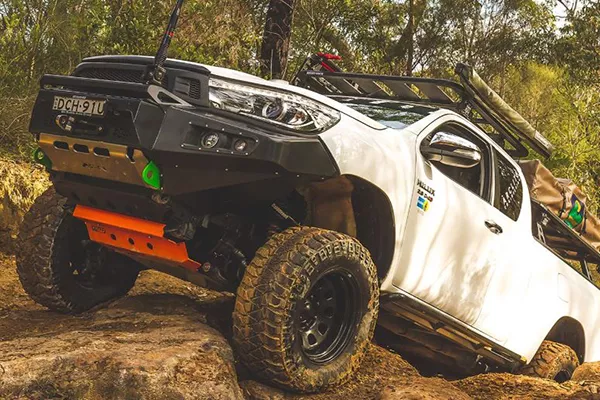
A kitted out 2017 Toyota Hilux 4x4 doing some gnarly climbs
When it comes to disadvantages, a 4WD is very maintenance hungry as its parts need regular attention especially if you neglect to use the system in a very long time.
Next, driving in 4WD as we’ve said earlier can burn a hole in your wallet especially if you use it when you don’t need to. This is because 4WD mode can burn a lot of gas and will damage your components if driven regularly on a regular road.
Don’t forget to turn it off. Vehicles with 4WD layouts common nowadays are the 2019 Toyota Fortuner 4x4, the 2019 Toyota Hilux 4x4, the 2019 Jeep Wrangler, and the newly launched 2019 Suzuki Jimny. AWD examples include; The 2019 Subaru Outback, 2019 Hyundai Genesis, the 2018 Mini Cooper, and the Lexus RX-350.
These are just some 4WD and AWD cars out there you can choose from. Vehicles with a 6x6 or 8x8 drivetrain is an entirely another story.
In conclusion, vehicle layouts can determine your choice for a vehicle because as we’ve said earlier, certain layouts can perform in certain situations better than others.
There are some cars out there though that will break the stereotype associated with its layout like the aforementioned Civic Type R. Regardless, it is better to know your vehicle better than having no idea at all right?
Thank you for reading and keep posted for more helpful car tips and advice here at Philkotse.com.
Recent posts
- Which car type is best for you - A Buyer's Guide May 24, 2023
- Best-selling cars vs Best-equipped cars: Which one would you pick as your next vehicle? Oct 18, 2022
- Top 11 easy to maintain cars in the Phillipines Mar 04, 2021
- Top reasons to buy a new car in the Philippines Mar 16, 2019
- What to save or spend on with a new car [Part 2] Mar 16, 2019


